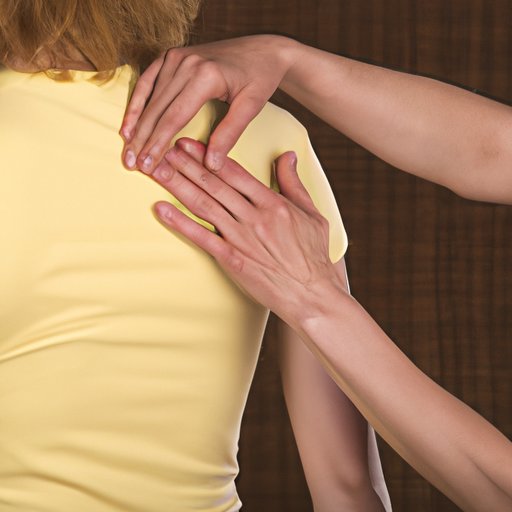
I. Introduction
If you’ve ever experienced pain, tingling, or numbness in your shoulder, you might have a pinched nerve. A pinched nerve occurs when there is too much pressure applied to a nerve by the surrounding tissues. It can be caused by injury, poor posture, or repetitive motions. Identifying and treating a pinched nerve in the shoulder is important to avoid further complications and chronic pain. In this article, we will explore various techniques and exercises to release a pinched nerve in the shoulder.
II. Self-Massage Techniques
Self-massage is a simple and effective way to relieve pain and release tension in the shoulder. It can help reduce inflammation and increase blood flow to the affected area. Here are the steps for performing self-massage to release a pinched nerve in the shoulder:
- Sit comfortably with your back straight and your feet flat on the ground.
- Use your opposite hand to apply pressure to the affected area in a circular motion.
- Gradually increase the pressure as tolerated and focus on any trigger points.
- Repeat on the other side if necessary.
Self-massage can be done using your hands, a tennis ball or foam roller. It is important to be gentle and avoid putting too much pressure on the affected area. Self-massage can be done multiple times a day for pain relief.
III. Stretching Exercises
Stretching is an effective way to alleviate nerve pain and prevent further injury. It helps to loosen tight muscles and improve flexibility. Here are some examples of stretching exercises to alleviate shoulder nerve pain:
- Neck and shoulder rolls
- Chest stretch
- Rotator cuff stretch
- Shoulder blade stretch
It is important to take precautions while stretching to avoid further injury. Do not force any stretches and avoid jerky movements. If you experience pain, stop immediately. Stretching should be done daily to prevent future pinched nerves in the shoulder.
IV. Heat Therapy
Heat therapy is a simple and effective way to reduce inflammation and ease nerve compression in the shoulder. Here are some ways to apply heat therapy:
- Use a heating pad or hot water bottle on the affected area for 15-20 minutes at a time.
- Take a warm bath or shower to relax the muscles in the shoulder.
- Use a microwavable heat pack to apply heat therapy on the go.
It is important to avoid applying heat directly to the skin or using heat therapy for more than 20 minutes at a time. Heat therapy can be done multiple times a day for pain relief.
V. Cold Therapy
Cold therapy is useful for numbing the affected area and relieving pain. It can be particularly helpful during the acute phase of a pinched nerve. Here are some ways to apply cold therapy:
- Use a cold compress or ice pack on the affected area for 10-15 minutes at a time.
- Take a cold shower to reduce inflammation in the shoulder.
- Use a bag of frozen peas or a towel soaked in cold water as a makeshift cold pack.
It is important to avoid using ice directly on the skin and limit the use of cold therapy to no more than 20 minutes at a time. Cold therapy can be done multiple times a day for pain relief.
VI. Acupuncture and Acupressure
Acupuncture and acupressure are ancient practices that can target nerve points and ease pain. They involve the insertion of needles or the application of pressure to specific points on the body. Here are some considerations when choosing acupuncture or acupressure for a pinched nerve in the shoulder:
- Choose a qualified practitioner with experience in treating pinched nerves and shoulder pain.
- Discuss any medical conditions or concerns with your practitioner before treatment.
- Be prepared for multiple sessions to achieve lasting results.
Acupuncture and acupressure can be effective in reducing inflammation and relieving pain. However, it is important to choose a qualified practitioner and discuss any concerns before treatment.
VII. Physical Therapy Exercises
Physical therapy is a widely used approach to treating a pinched nerve in the shoulder. It involves exercises to strengthen the shoulder and prevent future pinched nerves. Here are some examples of exercises that can be done with a physical therapist:
- Shoulder blade squeezes
- External rotation exercises
- Posterior capsule stretch
- Scapular retraction exercises
It is important to find a qualified physical therapist to ensure proper form and safety during exercises. Physical therapy can be done once or multiple times a week depending on the severity of the pinched nerve.
VIII. Alternative Therapies
Alternative therapies such as chiropractic adjustments or yoga can be effective at releasing tension and reducing nerve compression. Here are some considerations when choosing an alternative therapy:
- Choose a qualified practitioner with experience in treating pinched nerves and shoulder pain.
- Discuss any medical conditions or concerns with your practitioner before treatment.
- Be prepared for multiple sessions to achieve lasting results.
Alternative therapies can be effective in reducing inflammation and relieving pain. However, it is important to choose a qualified practitioner and discuss any concerns before treatment.
IX. Conclusion
Pinched nerves in the shoulder can be painful and debilitating, but there are numerous techniques and exercises available to help alleviate pain and release tension. Self-massage, stretching exercises, heat therapy, cold therapy, acupuncture, acupressure, physical therapy, and alternative therapies can all be effective in treating a pinched nerve in the shoulder. It is important to seek professional help if the pain persists and take preventive measures to avoid future pinched nerves in the shoulder.





